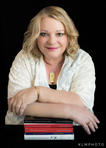The real roots of our ancestors
Thanks to social media and ourmutual friends and interests, I was introduced to the works of artistMartin Williamson. Martin hasgraciously agreed to allow the reproduction of his beautiful paintings in this Rootingfor Ancestors blog. What follows each image I've chosen is hisdescription of the painting, and my commentary as it relates to genealogyresearch. At the end of the post, I'll provide contact links for Martin, andlink you to his online gallery.
*****************
BoltonCastle, Wensleydale, Yorkshire
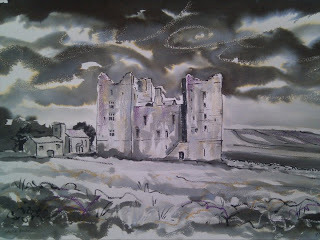
Martin: Bolton Castle, Wensleydale.
This imposing castle was built between 1378 and1399 by Richard le Scrope, 1st Baron Scrope of Bolton.What is quite staggering is the fact that the castle has never been sold and isstill in the ownership of the descendants of the Scrope family. The massiveouter walls of this very well-preserved site dominate the hamlet of CastleBolton that lies at its feet. In its dominating position overlooking thevalley, the castle is now a well-established major tourist attraction in thearea. Painted on location. Pen, brush and ink with wax resist. 22" x 15"
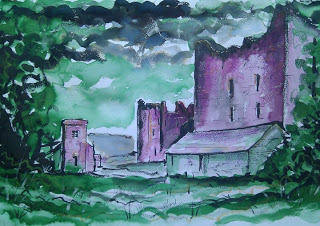 St. Oswald's Chapel at Castle BoltonChristy: The Scrope family were Normans who lived in Herefordshiredecades before the Norman invasion in 1066. Richard's Castle, near Ludlow, was built about1048-1050, and was their administrative center for the Welsh border area. Fourgenerations and about 75-80 years later, my branch of Scropes moved toYorkshire, to Flotmanby Manor south of Scarborough.Another three generations lived at Flotmanby and all were buried at Wensley Church. Finally, there is mention ofBolton, Yorkshire, with Sir William Scrope, 1259-1312.He is the father of (LordHenry) Scropeof Bolton and (SirGeoffrey) Scropeof Masham (14 miles away), both branches of which are my ancestorsbecause their descendants married as second cousins twice removed. Henry Scrope, 1271-1336,married Margaret de Ros(see Helmsley Castle in this article). Their son Richard Scrope was 1stBaron Scrope, Treasurer, Keeper of Great Seal, and Lord Chancellor until 1382, underRichard II. Richard Scrope was the builder of Bolton Castle, and thegrandfather of another RichardScrope, who married MargaretNeville, daughter of MargaretStafford and RalphNeville, 1st earl of Westmorland. Bolton Castle'ssubsequent history may be found at the link below.
St. Oswald's Chapel at Castle BoltonChristy: The Scrope family were Normans who lived in Herefordshiredecades before the Norman invasion in 1066. Richard's Castle, near Ludlow, was built about1048-1050, and was their administrative center for the Welsh border area. Fourgenerations and about 75-80 years later, my branch of Scropes moved toYorkshire, to Flotmanby Manor south of Scarborough.Another three generations lived at Flotmanby and all were buried at Wensley Church. Finally, there is mention ofBolton, Yorkshire, with Sir William Scrope, 1259-1312.He is the father of (LordHenry) Scropeof Bolton and (SirGeoffrey) Scropeof Masham (14 miles away), both branches of which are my ancestorsbecause their descendants married as second cousins twice removed. Henry Scrope, 1271-1336,married Margaret de Ros(see Helmsley Castle in this article). Their son Richard Scrope was 1stBaron Scrope, Treasurer, Keeper of Great Seal, and Lord Chancellor until 1382, underRichard II. Richard Scrope was the builder of Bolton Castle, and thegrandfather of another RichardScrope, who married MargaretNeville, daughter of MargaretStafford and RalphNeville, 1st earl of Westmorland. Bolton Castle'ssubsequent history may be found at the link below.More info: http://www.boltoncastle.co.uk/metadot/index.pl
HelmsleyCastle, north Yorkshire
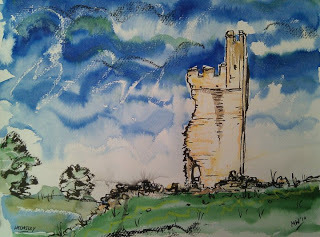 Martin: Helmsley Castle from North Gate This medieval castle ruin islocated in the market town of Helmsley, North Yorkshire.Originally it was built in wood around 1120. Now in the care of English Heritage.Painted on the spot. Mixed media. 15"x 11"
Martin: Helmsley Castle from North Gate This medieval castle ruin islocated in the market town of Helmsley, North Yorkshire.Originally it was built in wood around 1120. Now in the care of English Heritage.Painted on the spot. Mixed media. 15"x 11" Christy: Helmsley Castle was begun byWalter d'Espec ("the Woodpecker"), a prominent military and judicial figure inthe reign of Henry I. Walter also founded Kirkham Priory and Rievaulx Abbey. Becausehe was childless, upon his death Helmsley passed to his sister Adeline d'Espec and herhusband's hands, the powerful de Ros (Roos) family, who were barons, the progenitors ofScottish and English royalty, ancestors of the Neville family, and wereTemplars and Crusaders. The castle was improved by the de Ros's succeedinggenerations, and was "slighted" (destroyed) by Parliamentary forces in England's CivilWar.
More info: http://en.wikipedia.org/wiki/Helmsley_Castle
Peveril Castle,Castleton, Derbyshire
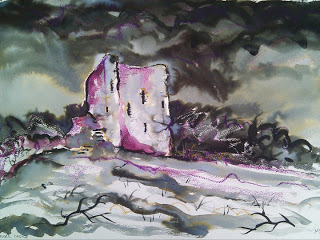 Martin: Peveril Castle, Derbyshire.
Martin: Peveril Castle, Derbyshire.The imposing ruins of PeverilCastle overlook the village of Castletonin the Derbyshire Peak District. The keep was built by Henry II in 1176, making the castle one ofthe earliest Norman fortresses in England. Now in the care of EnglishHeritage. Mixed media. 15" x 22"
Christy: The earliest-known ancestor of the Peverel name, William Peverel the Elder,born 1043 in York,came from a long line of Welsh people on his father's side, and a Saxon mother.His patrimony seems to have survived the Norman Conquest, which is quiteunusual for Welsh or Saxon landowners, so one might suppose that he fought onthe Norman side at Hastings and thereafter. His grandson WilliamPeverel the Younger committed the poisoning murder of Ranulph de Gernon, earl of Chester and hadhis lands seized by Henry II; and his granddaughter Margaret Peverel b. 1114, married into the de Ferrers family, earlsof Derby, andher tomb effigy still exists at the gatehouse chapel for Merevale Abbey inWarwickshire. Margaret Peverel Ferrers' son William Ferrers, 3rd earl of Derby, rebelled against Henry II and in 1155 losthis title and claim to the lands of Peverel. Two hundred years later, thatWilliam's eighth-generation descendant was Mary de Ferrers. Ralph Neville, secondearl of Westmorland (son of RalphNeville the first earl and Margaret Stafford, married Mary de Ferrers, granddaughter of Katherine Swynford and John of Gaunt, anddaughter of Joan Beaufortand Robert de Ferrers.It's all quite complicated, but I had to work in the Ralph Neville name to pumpmy blog hits—aren't I shameless!
More info: http://en.wikipedia.org/wiki/Peveril_Castle
Middleham Castle,Wensleydale, Yorkshire
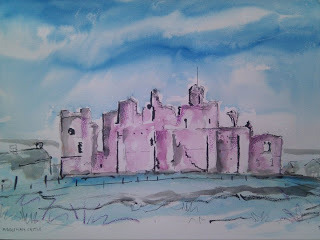 Martin: Middleham Castle.Middleham Castle inWensleydale, North Yorkshire, was built in1190 and was once the home of Richard III. The extensive site includes amassive Norman keep surrounded by a curtain wall. The ruins are now in the careof English Heritage. Painted on location.Pen, brush and ink with wax resist. 22" x 15"
Martin: Middleham Castle.Middleham Castle inWensleydale, North Yorkshire, was built in1190 and was once the home of Richard III. The extensive site includes amassive Norman keep surrounded by a curtain wall. The ruins are now in the careof English Heritage. Painted on location.Pen, brush and ink with wax resist. 22" x 15" Christy: RobertFitzralph 3rd Lordof Middleham and Spennithorne, 1110-1185, has a long line of ancestors back to the ninth century and beyond. Genealogy sites list his death as 1185, butevery site also says that Robert Fitzralph built the castle of Middleham"commencing in 1190"—apparently fiveyears after his death. (This looks like a job for the History Police,unless you attribute the work to his wife, Helewisa de Glanville and their young son.) Robert also founded Beauchief Abbey in Sheffield—luckily, though, while he was still alive! Hisand his son's (RanulfFitzrobert) tomb effigies were dug from the rubble of nearby CoverhamAbbey and their photo is contained in the header of this blog. Robert Fitzralphis the great-great grandfather of Ralph Neville, 1st earl Westmorland (Ralph Neville again?? He gets the most hitson this site!).
More info: http://www.middlehamonline.com/Middleham%20Castle.htmMore info: http://en.wikipedia.org/wiki/Middleham_Castle
Clifford's Tower, York Castle, Yorkshire
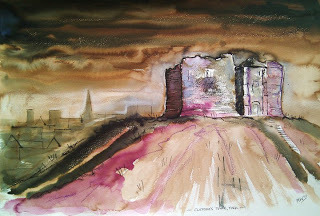 Martin: Clifford'sTower, York.
Martin: Clifford'sTower, York.Clifford's Tower is actually the remains of the13th century keep of York Castle, sat on top of amotte, or defensible mound. The keep is of unusual design, being quatrefoil inplan (four overlapping circles) and is the only example of this kind in England. Todayit is a well-known and instantly-recognizable tourist attraction, oftenphotographed in the spring with the motte ablaze with daffodils and the Towerset against a clear blue sky. I have portrayed the Tower rather differently,perhaps hinting at its more brutal past: the name 'Clifford's Tower' comes fromRoger de Clifford who was hanged there in 1322. Clifford's Tower is now in the care of EnglishHeritage. Pen, ink, wax resist and chalk.15" x 22"
Christy: Roger, second Lord Clifford, who was hanged in 1322 byHugh Despenser the Younger, was my "uncle," so all Roger's ancestors are alsomine. His sister, Idoine de Clifford,was born c 1300, married Henryde Percy, 2nd Lord of Alnwick, 1st Earl Northumberland, and died 24 Aug1365. Clifford's Tower is the keep for York Castle,which was a royal fortress established by William I, and rebuilt in stone by Henry III.
More info: http://www.cliffordstower.com/ More info: http://en.wikipedia.org/wiki/York_Castle
DolwyddelanCastle, north Wales
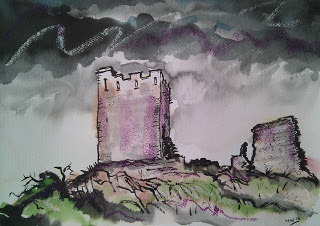 Martin: Dolwyddelan Castlenear Betws-y-coed. This is s very striking ruincommanding a wonderful position on top of a ridge with stunning panoramicviews. Dolwyddelan stands alone in a country of castles as it was built about1210 by the Welsh princes, not by English or Norman forces. Painted on the spotin mixed media.
Martin: Dolwyddelan Castlenear Betws-y-coed. This is s very striking ruincommanding a wonderful position on top of a ridge with stunning panoramicviews. Dolwyddelan stands alone in a country of castles as it was built about1210 by the Welsh princes, not by English or Norman forces. Painted on the spotin mixed media.Christy: Dolwyddelan Castlewas a native Welsh castle located near Conwy. It was built between 1210 and1240 by Llywelyn the Great ap Iorweth, Prince ofGwynedd and North Wales. The Welsh castlefunctioned as a fortress. On January 18, 1283, it was captured by Edward I of England ("Longshanks") inhis conquest of Wales.The castle was then modified and strengthened for occupation by an Englishgarrison.
More info: http://www.castlewales.com/dolw.html More info: http://en.wikipedia.org/wiki/Dolwyddelan_Castle
Chirk Castle, Wales
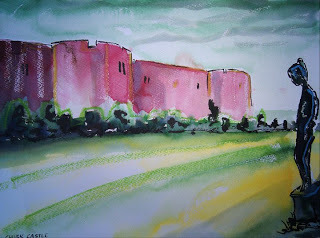 Martin: Chirk Castle.
Martin: Chirk Castle.Completed in 1310, Chirk Castleis the last Welsh castle from the reign of Edward I still lived in today. Builtby Roger Mortimer, Justice of North Wales for Edward I, the castle commands aprime position overlooking the Ceiriog valley. The castle was sold for 5,000pounds to Sir Thomas Myddelton in 1595. Sir Thomas's descendants continue tolive in part of the castle today, although the National Trust now care for theproperty. Mixed media on 230gsm paper.14.5" x 10.5"
Christy: Some reports say that Roger Mortimer (one of many "RogerMortimer" fathers, sons, and cousins) built the castle of Chirkon land he had been granted in 1282. That Roger died during lifetime imprisonment inthe Tower of London in 1326, and his grandson John Mortimer signed over hisrights to Chirk Castle to his cousin Roger Mortimer 2nd earl ofMarch (brother of my ancestor Isabella Mortimer Fitzalan), in 1359. Another version has it that Roger Mortimer 1stEarl of March (rebel against Edward II and one of the regents to Edward III before Roger's execution in1330) built the castle in 1295 as part of the Edwardian chain of Welsh castles.
More info: http://www.castlewales.com/chirk.htmlMore info: http://en.wikipedia.org/wiki/Chirk_Castle
*****************Thank you again, Martin, for beingso agreeable about sharing your fine art. Readers, if you enjoy his paintings,please observe international copyright laws and contact him for permission toreproduce the images—or perhaps to enquire about purchasing a print, orcommissioning a canvas depicting your ancestors' landscapes or edifices.Remember: images ©Martin Williamson 2011. Thisis the link tohis contact information. Martin welcomes friends to his Facebook pages, and you'll find that link in his website.
I've selected a few of Martin's churches to feature at another time, which connect with ancestors or their burials. Are you interested? What do you think of this blog post? Leave a comment below!
Published on August 03, 2011 13:49
No comments have been added yet.

